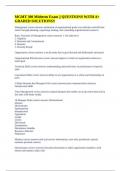Exam (elaborations)
MGMT 300 Midterm Exam || QUESTIONS WITH A+ GRADED SOLUTIONS!!
- Course
- Institution
Management correct answers attainment of organizational goals in an effective and efficient matter through planning, organizing, leading, and controlling organizational resources Basic Functions of Management correct answers 1. Set objectives 2. Organize 3. Motivate and Communicate 4. Measure...
[Show more]



